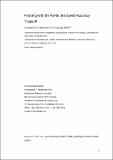| dc.contributor.author | Michmizos, Konstantinos | |
| dc.contributor.author | Krebs, Hermano Igo | |
| dc.date.accessioned | 2016-08-11T18:37:15Z | |
| dc.date.available | 2016-08-11T18:37:15Z | |
| dc.date.issued | 2013-11 | |
| dc.date.submitted | 2013-06 | |
| dc.identifier.issn | 0014-4819 | |
| dc.identifier.issn | 1432-1106 | |
| dc.identifier.uri | http://hdl.handle.net/1721.1/103901 | |
| dc.description.abstract | This study investigated the trade-off between speed and accuracy in pointing movements with the ankle during goal-directed movements in dorsal–plantar (DP) and inversion–eversion (IE). Nine subjects completed a series of discrete pointing movements with the ankle between spatial targets of varying difficulty. Six different target sets were presented, with a range of task difficulty between 2.2 and 3.8 bits of information. Our results demonstrated that for visually evoked, visually guided discrete DP and IE ankle pointing movements, performance can be described by a linear function, as predicted by Fitts’ law. These results support our ongoing effort to develop an adaptive algorithm employing the speed-accuracy trade-off concept to control our pediatric anklebot while delivering therapy for children with cerebral palsy. | en_US |
| dc.description.sponsorship | Cerebral Palsy International Research Foundation (CPIRF) | en_US |
| dc.description.sponsorship | Stavros S. Niarchos Foundation | en_US |
| dc.description.sponsorship | Baltimore VA Medical Center (contract 512-D05015) | en_US |
| dc.description.sponsorship | National Institutes of Health (U.S.) (NIH Grant R01HD069776-02) | en_US |
| dc.description.sponsorship | Foundation for Education and European Culture (IPEP) | en_US |
| dc.publisher | Springer Berlin Heidelberg | en_US |
| dc.relation.isversionof | http://dx.doi.org/10.1007/s00221-013-3773-0 | en_US |
| dc.rights | Article is made available in accordance with the publisher's policy and may be subject to US copyright law. Please refer to the publisher's site for terms of use. | en_US |
| dc.source | Springer Berlin Heidelberg | en_US |
| dc.title | Pointing with the ankle: the speed-accuracy trade-off | en_US |
| dc.type | Article | en_US |
| dc.identifier.citation | Michmizos, Konstantinos P., and Hermano Igo Krebs. “Pointing with the Ankle: The Speed-Accuracy Trade-Off.” Experimental Brain Research 232, no. 2 (November 23, 2013): 647–657. | en_US |
| dc.contributor.department | Massachusetts Institute of Technology. Department of Mechanical Engineering | en_US |
| dc.contributor.department | McGovern Institute for Brain Research at MIT | en_US |
| dc.contributor.mitauthor | Michmizos, Konstantinos | en_US |
| dc.contributor.mitauthor | Krebs, Hermano Igo | en_US |
| dc.relation.journal | Experimental Brain Research | en_US |
| dc.eprint.version | Author's final manuscript | en_US |
| dc.type.uri | http://purl.org/eprint/type/JournalArticle | en_US |
| eprint.status | http://purl.org/eprint/status/PeerReviewed | en_US |
| dc.date.updated | 2016-05-23T12:09:28Z | |
| dc.language.rfc3066 | en | |
| dc.rights.holder | Springer-Verlag Berlin Heidelberg | |
| dspace.orderedauthors | Michmizos, Konstantinos P.; Krebs, Hermano Igo | en_US |
| dspace.embargo.terms | N | en |
| mit.license | PUBLISHER_POLICY | en_US |
